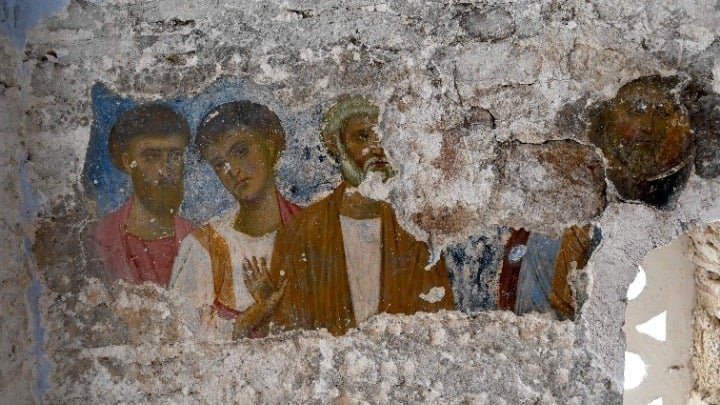
In an astonishing discovery, intact Byzantine-era frescoes have been unearthed beneath the white walls of the Church of Saint Nicholas in Mesopotamia, Albania.
Archaeologists and conservators from the European Centre for Byzantine and Post-Byzantine Monuments were thrilled to find vibrantly colored figures of saints, preserved for centuries at a height of eight meters.
Flora Karagianni, the Centre’s director, expressed immense joy, stating to the Athens-Macedonia News Agency (AMNA), “This has not happened anywhere else. In other monuments that we conserve outside Greece, the frescoes are always known; we just go there and do cleaning, fixing. We experienced this joy of revelation very intensely in the church of Saint Nicholas.”

The story of the Church with the Byzantine frescoes in Albania
According to civil engineer Leonidas Pappas, a scholar of monument restoration and former president of “Omonia” (representing Greeks in Albania), local tradition suggests the monastery of Saint Nicholas in Mesopotamia, a village in northern Epirus, in today’s Albania. was built around 1050 during the reign of Emperor Constantine the Conqueror.
The church holds a unique place in history, having survived the forty-year rule of Albanian leader Enver Hoxha, who systematically destroyed religious buildings. It was one of only 350 churches spared from demolition or conversion into agricultural storage.

Pappas also recounted a fascinating, albeit unconfirmed, hypothesis proposed by historian and architect Alexander Mexi, the first prime minister of post-colonial Albania.
Mexi suggested that the church once operated with two sanctuaries, serving both Orthodox and Catholic congregations during the Despotate of Epirus, when the region was under the rule of the House of Anjou. While Pappas considers this unlikely and possibly a theory spread for tourism, it highlights the rich and complex history of the site.

Pappas also shared a poignant family tale passed down through generations: that of a girl who, pregnant out of wedlock 150 years ago, sought refuge in the church from threats on her life. The monastery protected her, and she later gave birth there before marrying a relative of Pappas.
Meticulous conservation and future plans

The conservation work at the Church of Saint Nicholas has unfolded in phases. The Institute of Monuments of the Ministry of Culture of Albania initially undertook efforts to strengthen the building.
This was followed by the second phase, led by the European Centre for Byzantine Monuments, focusing on the preservation of the church’s decorative elements, including the newly revealed frescoes and sculptures.
Pappas noted that the vibrant colors used in the frescoes were likely derived from plants, as pigments were not commonly available or were very expensive at the time. This suggests that a prominent individual of the era likely financed the church’s elaborate artwork.
This second phase of work is a testament to international collaboration, implemented under a Memorandum of Cooperation signed in 2021 between the Centre’s president, Natalia Poulou, and Albania’s then-Minister of Culture, Elma Margariti.
Funded by the Greek Ministry of Culture, the conservation of the frescoes is slated for completion in 2026. The project has seen close cooperation between the Centre and the Institute of Monuments of Albania, with practical assistance from the Municipality of Finiq and support from the Greek Embassy in Tirana and the Consulate General of Gjirokastër.
The European Centre’s global impact
The discovery at Saint Nicholas is part of a broader mission undertaken by the European Centre for Byzantine and Post-Byzantine Monuments. For approximately 28 years, the Centre has been dedicated to implementing conservation and restoration programs for Byzantine monuments outside Greece.
Karagianni highlighted the Centre’s extensive work, which spans the Balkans, the Middle East, Turkey, and the Black Sea. Through memoranda of cooperation with local Ministries of Culture or churches, and with funding from the Greek Ministry of Culture, these projects aim to preserve and highlight invaluable cultural heritage.
Notable past projects include the preservation of mosaic floors in the early Christian basilica of Prophet Elias in Jordan, frescoes in North Macedonia, and wood-carved icons and shrines of the Ecumenical Patriarchate. As Karagianni told AMNA, “Each case is unique.”
Related: The Greek Church With the Finest Byzantine-Era Frescoes

